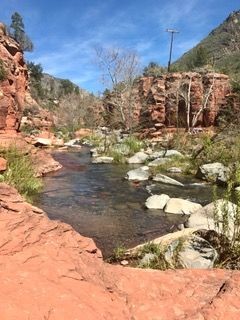As I move through the beauty of Sedona, Arizona I watch everyone take out their cameras and click pictures on the trail, and then, as if the moment were successfully captured, move on. It is amazing. Once we had to save our film because it was finite and costly. I started thinking about what people did before they had cameras to engrave a moment in their memory – pictures only convey the visual, not the smells or the auditory or the kinesthetic. They seem so limited. People drew or painted or composed poems or postcards. In some cases, graffiti, ancient and new, communicated, "We were here." They pocketed little rocks or bought mementos to remember that they had experienced this. But was there a time and a way in which we could simply say that my being is changed by having been here without taking anything concrete with us? "Time sits in places," is an Apache saying. I know that from experiencing Israel and feeling the ancient as present. Artist, Paul Kessel wondered if time also sits in people. Undoubtedly, it does.
Sitting by a creek in Oak Creek Canyon, Arizona, I listen to the echoing burbling of the water as it pours onto the stones following its inexorable current. It's cool here with a soft wind caressing my skin. I hear birds calling out for their mates. By being here in this place, by being receptive – is my body shifting, developing memories and associations that will continue? I think so. What does it take to engrave this experience upon memory – awe. I'm not a religious person, but I do have a spiritual nature and it seemed important to recite the shehechiyanu - giving thanks that I am fortunate enough to reach this day. Spirituality may be the nature of allowing ourselves to be receptive to the wonder of life and in this way through our wonder and our gratitude, our being does change.
